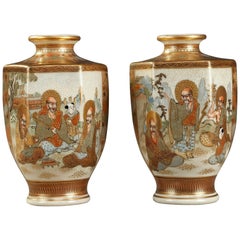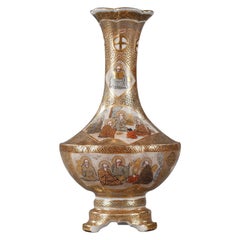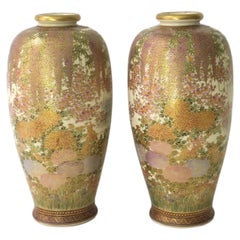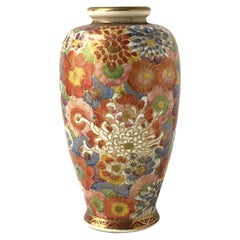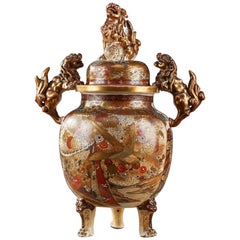Satsuma Furniture
to
2
2
2
2
1
1
1
1
2
2
2
2
2
2
18
11
4
3
2
Creator: Satsuma
Dealer: Atena
20th Century Pair of Small Porcelain Satsuma Vases
By Satsuma
Located in Paris, FR
Two porcelain hexagonal Satsuma vases painted in polychrome enamels and gold. The paunch is decorated with intricate Japanese characters in a landscape, the neck and the shoulder wit...
Category
Early 19th Century Japanese Japonisme Antique Satsuma Furniture
Materials
Porcelain
Small Tripod Satsuma Vase Decorated with the 18 Luohans, 19th Century
By Satsuma
Located in Paris, FR
Small tripod vase with narrow neck decorated with polychrome and gold enamels in Satsuma ware. The lip is multi-lobed and underlined with gold. The decoration is composed of haloed characters in cartouches on a dotted background. They are the 18 Luohans...
Category
19th Century Japanese Antique Satsuma Furniture
Materials
Enamel
Related Items
Japanese Satsuma Vases, Pair
By Satsuma
Located in New York, NY
A gorgeous pair of Japanese earthenware Satsuma vases, hand-painted, Meiji period, circa early-20th century, Japan. Vases' beautiful decoration is high-quality, hand-painted, and ext...
Category
Early 20th Century Japanese Meiji Satsuma Furniture
Materials
Earthenware
Japanese Satsuma Vase
By Satsuma
Located in New York, NY
A gorgeous hand-painted Japanese Satsuma vase, Meigi, circa 20th century, Japan. Beautiful hand-painted detail of colorful flowers and spider mum flowers around finished with gold de...
Category
20th Century Japanese Meiji Satsuma Furniture
Materials
Earthenware
Japanese Satsuma Vase Landscape Figural Decoration Marked, 19th Century
Located in Amsterdam, Noord Holland
Fabulous Japanese earthenware Satsuma Vase with nice decoration of a landscape with figures. Meiji period, 19th c.
Lovely piece.
Additional information:
Material: Porcelain & Potte...
Category
19th Century Japanese Meiji Antique Satsuma Furniture
Materials
Porcelain
Giant Herend Chinese Bouquet Lidded Porcelain Vase, Mid-20th C
Located in Copenhagen, DK
Giant Herend Chinese Bouquet lidded porcelain vase with hand-painted green flowers and gold decoration.
Mid-20th century.
Measures: 58 x 33 cm
In excellent condition.
Stamped.
Category
Mid-20th Century Hungarian Satsuma Furniture
Materials
Porcelain
19th Century Large Japanese Satsuma Vase, Ric.048
Located in Norton, MA
Meiji period, Large Satsuma Porcelain vase, decorated with dragon and floral pattern.
Category
19th Century Japanese Art Nouveau Antique Satsuma Furniture
Materials
Porcelain
19th Century Satsuma Vase or Lamp
Located in Brighton, Sussex
A good quality late 19th century (Meiji period 1868-1912) Japanese satsuma vase or lamp. Having classical gilded decoration of flowers, birds and scholars. Mounted on a fretted ormol...
Category
Late 19th Century Japanese Antique Satsuma Furniture
Materials
Porcelain
Japanese Satsuma Vase Landscape Figural Decoration Marked, 19th Century
Located in Amsterdam, Noord Holland
Fabulous Japanese earthenware Satsuma bowl with nice decoration of a landscape with figures. Meiji period, 19th c.
Lovely piece.
Additional information:
Material: Porcelain & Pott...
Category
19th Century Japanese Meiji Antique Satsuma Furniture
Materials
Porcelain
Early 20th Century Royal Copenhagen Porcelain Vase with a Large Chrysanthemum
By Royal Copenhagen
Located in Philadelphia, PA
A very good and large-scale, early 20th century Royal Copenhagen porcelain vase.
With decoration that includes two very large Chrysanthemum flowers painted in muted blues and a ex...
Category
Early 20th Century Danish Japonisme Satsuma Furniture
Materials
Porcelain
Pair of Antique Meiji Japanese Satsuma Vases, 19th Century
Located in Amsterdam, Noord Holland
Amazing piece with beautiful decoration in different kind of panels. Visible are birds, flowers, objects and a cart. High quality painting.
Additional information:
Material: Porcela...
Category
19th Century Japanese Antique Satsuma Furniture
Materials
Porcelain
Japanese Satsuma Vase, Early 20th Century
Located in New York, NY
A beautiful Japanese Satsuma vase, circa early-20th century, late 1930s-1940s, Japan. Colors include red, black, gold, yellow, white, burgundy, green, and flesh tones. Dimensions: 5"...
Category
1930s Japanese Vintage Satsuma Furniture
Materials
Ceramic, Earthenware, Pottery
Set of 4 Antique Japanese Satsuma Vase Decorated Marked Base Japan, 19th Century
Located in Amsterdam, Noord Holland
Lovely detailed pieces. Marked on base.
Additional information:
Material: Porcelain & Pottery
Region of Origin: Japan
Period: Meiji Periode (1867-1912)
Age: ca 1900
Original/Reprodu...
Category
19th Century Japanese Antique Satsuma Furniture
Materials
Porcelain
H 0.04 in Dm 2.37 in
A finely-decorated Satsuma earthenware Vase, gold gilt, hand-painted, 18/1900s
By Satsuma
Located in Skien, NO
A Japanese antique vase - finely-decorated / hand-painted Satsuma earthenware vase from ca. Meiji era (1868-1912) or late 19th/early 20th century, depicting temples amongst fjell and...
Category
Early 20th Century Japanese Satsuma Furniture
Materials
Earthenware, Stoneware
Previously Available Items
19th Century Pair of Small Vases with Battle Scenes
By Satsuma
Located in Paris, FR
Pair of Satsuma small vases crafted of porcelain, ornamented with polychrome enamels and gold. The paunch is decorated with intricate Japanese characters...
Category
Late 19th Century Japanese Japonisme Antique Satsuma Furniture
Materials
Porcelain
Japanese Satsuma Perfume-Burner with Dogs of Fô
By Satsuma
Located in Paris, FR
Tripod Satsuma perfume-burner painted in polychrome enamels and gold. The paunch is decorated with Japanese courtiers, the reverse with birds in landscapes. The shoulder and lid are embellished with flowers and geometric patterns. The handles and lid are topped by dogs of Fô...
Category
19th Century Japanese Japonisme Antique Satsuma Furniture
Materials
Enamel
Late 19th Century Pair of Japanese Satsuma Vases
By Satsuma
Located in Paris, FR
Pair of baluster-shaped vases painted in polychrome enamels and gold. The paunch is decorated with two panels depicting samurai, the reverse with Japanese courtiers, the neck and the shoulder with stylised flowers and other geometric patterns. Satsuma, Japan. Meiji period (1868-1912). Good vintage condition.
Satsuma ware (Satsuma-yaki) is a type of Japanese pottery originally from Satsuma Province, southern Kyushu. Today, it can be divided into two distinct categories: the original plain dark clay early...
Category
Late 19th Century Japanese Japonisme Antique Satsuma Furniture
Materials
Enamel
Satsuma furniture for sale on 1stDibs.
Satsuma furniture are available for sale on 1stDibs. These distinctive items are frequently made of ceramic and are designed with extraordinary care. There are many options to choose from in our collection of Satsuma furniture, although brown editions of this piece are particularly popular. Many of the original furniture by Satsuma were created in the neoclassical style in east asia during the 19th century. If you’re looking for additional options, many customers also consider furniture by Imari Porcelain, Ando Jubei, and Kinkozan. Prices for Satsuma furniture can differ depending upon size, time period and other attributes — on 1stDibs, these items begin at $382 and can go as high as $16,800, while a piece like these, on average, fetch $2,300.
Creators Similar to Satsuma
Questions About Satsuma Furniture
- 1stDibs ExpertApril 5, 2022Satsuma porcelain or pottery includes a maker’s mark with the name of the person who made the item. Japanese numbers may also indicate that a Satsuma piece was part of a collection. Genuine Satsuma pieces will not have a “Made in Japan” label and should only include Japanese characters. When in doubt, work with a certified appraiser to determine the authenticity of your Satsuma piece. Find a variety of expertly vetted Satsuma porcelain and pottery collectibles on 1stDibs.
- Is Satsuma pottery valuable?1 Answer1stDibs ExpertApril 26, 2024Yes, some Satsuma pottery is valuable. The age, type, style and condition will determine how much a particular piece is worth. In addition, the history of ownership may also make a piece more valuable. For example, if a piece was previously in the collection of a notable person, such as a member of the Japanese Imperial Family, it may be worth more. To get an estimated value for a particular piece, consult a certified appraiser or knowledgeable antiques dealer. Find a range of Satsuma pottery on 1stDibs.
- How do I date a Satsuma vase?1 Answer1stDibs ExpertMarch 22, 2022To date a Satsuma vase, study its mark. Vases made before World War II normally feature a mark in Japanese. A vase that says "Royal Satsuma" likely dates back to the late 20th century. You'll find a variety of expertly vetted Satsuma vases on 1stDibs.
- What is a Japanese Satsuma vase?1 Answer1stDibs ExpertOctober 12, 2021A type of Japanese pottery originated from Satsuma province in Japan is termed as Satsuma ware. A vase of this kind is known as a Satsuma vase. An interesting fact about Satsuma ware is that they feature a "makers mark" or marking as a key to help collectors unlock the value, age and authenticity of the piece. Shop a range of antique and vintage Japanese vases on 1stDibs.
- 1stDibs ExpertOctober 7, 2024The difference between Satsuma and moriage is that the former is a type of pottery, and the latter is a technique for decorating pottery. Satsuma pottery is the term for earthenware pottery from Japan's Satsuma region. Although there are different styles, the most common element of Satsuma pottery is a heavy, dark glaze. Moriage is the term for when potters add raised slip decorations to pottery, creating a three-dimensional effect. Some Satsuma pieces show off moriage details, while others do not. Shop a range of Satsuma pottery on 1stDibs.
- 1stDibs ExpertNovember 4, 2024To identify Satsuma pottery marks, you'll typically need to perform research using trusted online resources. Satsuma is a region in Japan known for its pottery, and many factories and artisans have operated there, including Kinkozan, Taizan, Yasuda, Choshuzan, Fuzan, Gyozan, Koshida and Maruni Kobe. Each maker has its own marks associated with it, and these typically are in Japanese kanji characters. You can compare the characters on your piece to pictures shared online to find a match. Alternatively, a certified appraiser or experienced antique dealer can help you identify your pottery markings. On 1stDibs, shop a selection of Satsuma pottery.
- 1stDibs ExpertFebruary 1, 2024One way to tell if your Satsuma vase is valuable is to look for markings on it. The oldest and typically most expensive pieces will usually have the Shimazu family crest — a circle with a cross through it — hand-painted on the bottom. If the piece is stamped with the marking or says "Made in Japan" in the Roman alphabet, it is a newer vase. Factors like the style of the vase and its condition will also impact its price. It's a good idea to have a certified appraiser or knowledgeable dealer evaluate your vase to determine its value. Find a variety of Satsuma vases on 1stDibs.
- 1stDibs ExpertSeptember 9, 2024Yes, some Satsuma pottery is worth something. Depending on their age, maker, type, style, condition and other factors, pieces may sell for a few hundred to several thousand dollars. Looking at sales and auction histories can give you a rough idea of the value of a piece. For a more definitive valuation, use the services of a certified appraiser or knowledgeable antique dealer. On 1stDibs, explore a collection of Satsuma pottery.
